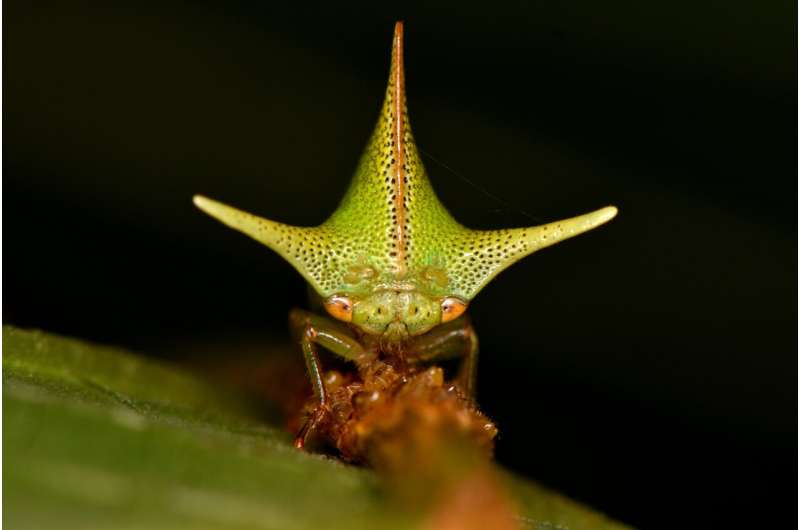A new study suggests that the ability of treehopper insects to detect static electricity may explain their unique and diverse body shapes. Researchers from the University of Bristol, led by Dr. Sam England and Professor Daniel Robert, published their findings in the Proceedings of the National Academy of Sciences on August 2, 2025. This hypothesis marks a significant advancement in understanding the evolutionary adaptations of these insects.
Treehoppers are renowned for their incredible morphological diversity, with over 3,000 species exhibiting a wide range of shapes, including horns, spines, and tridents. While naturalists have long been fascinated by these unusual forms, scientists have struggled to determine their specific functions. Traditional explanations such as camouflage or mimicry do not universally apply across the entire family of treehoppers.
In their research, Dr. England and Professor Robert explored the connection between treehoppers’ extreme body shapes and their ability to sense static electricity. Previous studies indicated that other insects, such as bees and caterpillars, can detect static fields. The researchers sought to determine whether treehoppers might possess similar abilities that could be linked to their unique morphologies.
The team discovered that predatory wasps produce static electricity and that treehoppers tend to retreat from electric fields. By employing computational methods, they demonstrated that the distinct shapes of treehoppers enhance the electric field strength around them, likely increasing their sensitivity to static electricity. This suggests a potential evolutionary advantage in detecting threats.
Moreover, the study revealed that the electrostatic charges of predatory wasps differ significantly from those of stingless bees, which often protect treehoppers. This difference could enable treehoppers to discern between potential threats and allies based solely on electrical cues.
Dr. England expressed enthusiasm about the implications of their findings, stating, “We think our study provides a really exciting launch pad for investigating static electricity as a driver of organismal morphology more generally.” He emphasized that many other species, including various insects and plants with extreme shapes, remain unexplained, highlighting the significance of this research.
The researchers plan to delve deeper into how different treehopper morphologies may be adaptive to specific electrical environments. Dr. England noted, “If we can link treehopper shapes to certain aspects of their electrical ecology, like specific predators which approach from certain angles with particular static charges, this would really begin to strongly support our ideas around static electricity as an evolutionary driver.”
The study provides the first evidence of the role of electroreception in driving morphological evolution, paving the way for further exploration into how environmental factors influence the development of unique biological forms. As researchers continue to investigate these relationships, the findings could reshape our understanding of evolutionary biology.
For more information, refer to the full study: Sam J. England et al, “Electroreception in treehoppers: How extreme morphologies can increase electrical sensitivity,” Proceedings of the National Academy of Sciences, DOI: 10.1073/pnas.2505253122.
